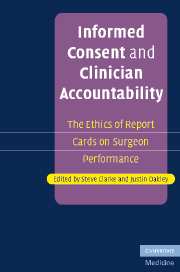Book contents
- Frontmatter
- Contents
- List of contributors
- Acknowledgements
- Introduction: Accountability, informed consent and clinician performance information
- Part I Accountability
- Part introduction
- 1 Clinician report cards and the limits of evidence-based patient choice
- 2 Report cards for institutions, not individuals
- 3 Safety, accountability, and ‘choice’ after the Bristol Inquiry
- 4 Public reports: putting patients in the picture requires a new relationship between doctors and patients
- 5 Adverse event disclosure: benefits and drawbacks for patients and clinicians
- 6 Report cards and performance monitoring
- Part II Informed consent
- Part III Reporting performance information
- Index
- References
6 - Report cards and performance monitoring
Published online by Cambridge University Press: 08 August 2009
- Frontmatter
- Contents
- List of contributors
- Acknowledgements
- Introduction: Accountability, informed consent and clinician performance information
- Part I Accountability
- Part introduction
- 1 Clinician report cards and the limits of evidence-based patient choice
- 2 Report cards for institutions, not individuals
- 3 Safety, accountability, and ‘choice’ after the Bristol Inquiry
- 4 Public reports: putting patients in the picture requires a new relationship between doctors and patients
- 5 Adverse event disclosure: benefits and drawbacks for patients and clinicians
- 6 Report cards and performance monitoring
- Part II Informed consent
- Part III Reporting performance information
- Index
- References
Summary
Introduction
There is little doubt that report cards provide valuable information to enable surgeons to improve outcomes for patients. However, we believe report cards for surgeons are only the first step towards a systematic improvement of all healthcare outcomes for all patients. There is no reason why report cards should be confined to surgeons, and our work with anaesthetists at Geelong Hospital confirms this view. Furthermore, we believe that the crude mortality rates, or even risk-adjusted mortality rates, currently provided to surgeons are the early primitive analyses that will be replaced by more meaningful performance charts as these become more accepted by the healthcare professions. Again, our work in Geelong supports this contention. We believe that local data collection by the healthcare worker is a reliable and trusted means of entering data into appropriate databases for analysis. Our reasons for reaching this conclusion relate to two considerations of the trust that this data requires. Firstly, the individual whose performance is to be assessed or monitored by the data collection must trust the data. Some of the early data collections were not trusted by the clinician participants, and this led to a mistrust of databases by clinicians in practice (Black, 1997, 1999a). However, the conclusions from the work of Professor Nick Black, an epidemiologist at the London School of Hygiene and Tropical Medicine, is that better databases will gain the confidence of clinicians; and collecting data relating to performance in a manner that clinicians believe contains the relevant data on their performance will improve the performance of individuals and organisations (Black and Payne, 2003).
- Type
- Chapter
- Information
- Informed Consent and Clinician AccountabilityThe Ethics of Report Cards on Surgeon Performance, pp. 91 - 106Publisher: Cambridge University PressPrint publication year: 2007
References
- 1
- Cited by



